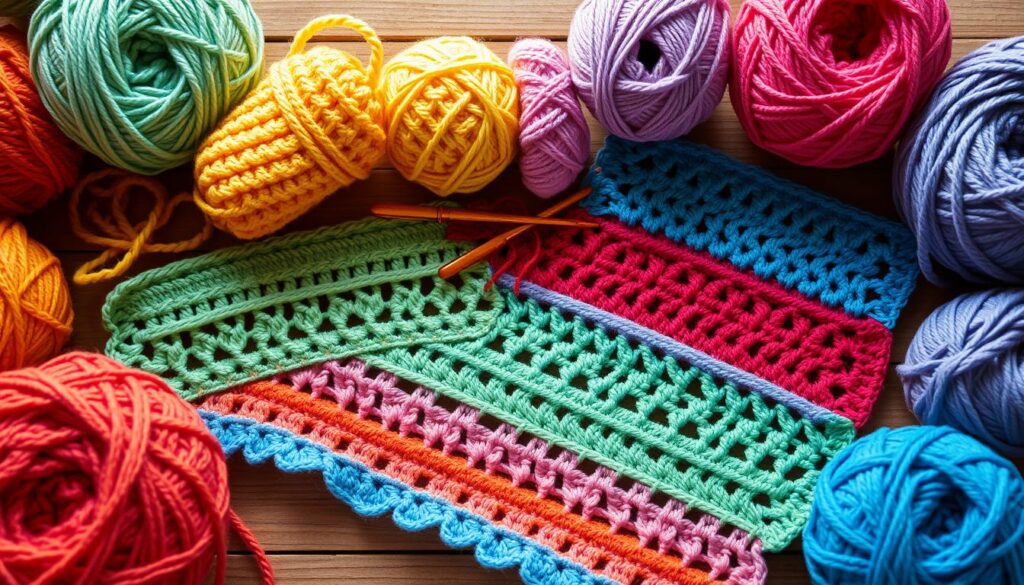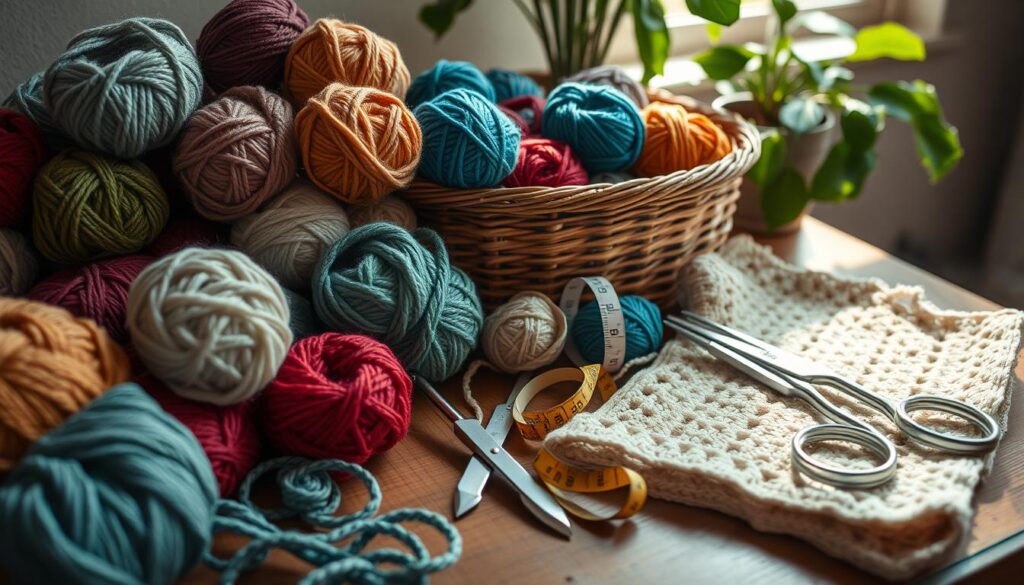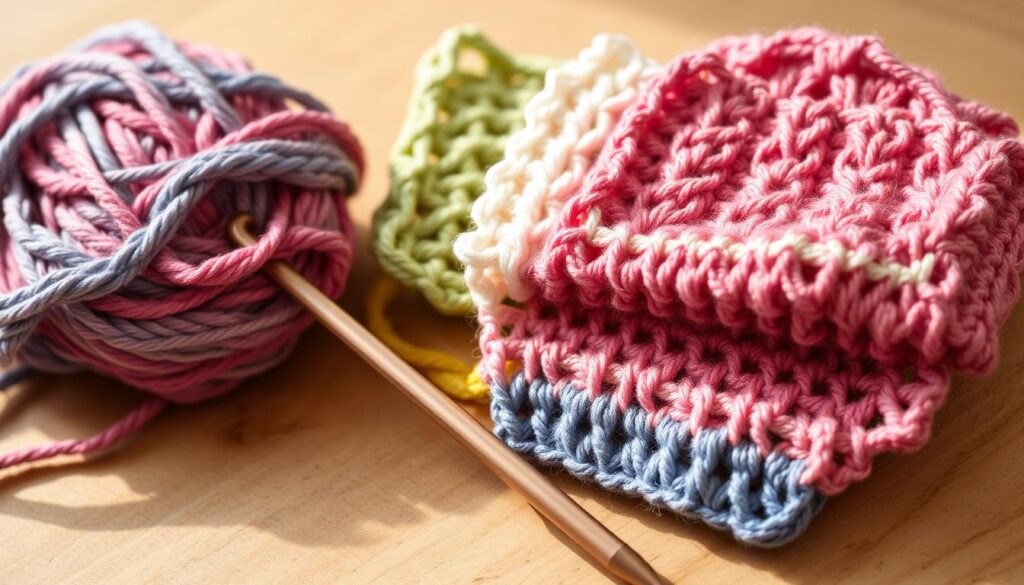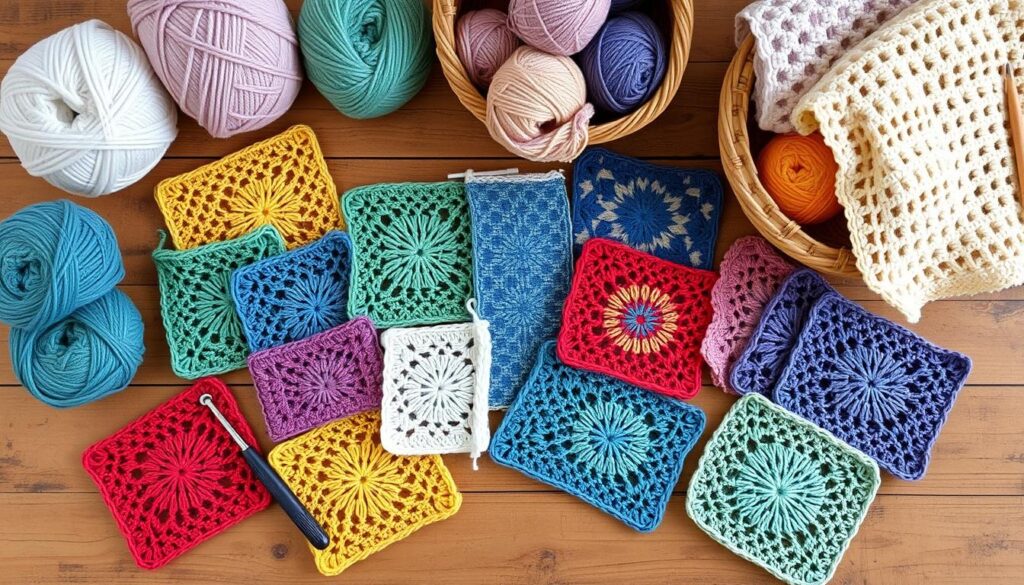Crochet has been loved for centuries and is still popular today. Many people enjoy it as a fun and calming hobby. You can learn to crochet and make beautiful things with just a few tools and simple steps. This guide will teach you everything you need to know to start how to crochet, from holding your hook to the most common crochet stitches.
Starting your crochet 101 journey is exciting. You’ll find joy in making something with your hands. With practice, you’ll get better at the crochet basics and then tackle more challenging projects. If you’re looking for a new hobby or just want to try something different, crocheting is a wonderful choice.
Key Takeaways
- You can learn to crochet and create beautiful projects using just a few basic tools and techniques.
- Crocheting is a fun and relaxing hobby that can be enjoyed by anyone.
- The basics of crocheting include holding your hook, creating a slip knot, and mastering basic stitches like the single crochet.
- There are many resources available to help you learn how to crochet, including video tutorials and online patterns.
- With practice and patience, you can master the crochet basics and move on to more complex projects.
- Crocheting is a great way to create something with your own hands and express your creativity.
- You can find many free crochet patterns online, including those for beginners.
What is Crocheting?
Crocheting is a craft that uses a hooked needle to make fabric from yarn or thread. It has a long history of crochet that spans centuries and continents. You can make everything from delicate lace to sturdy blankets, with endless possibilities.
As a beginner, you’ll start with the basics. You’ll learn the key crochet techniques and essential crochet stitches. The main crochet stitches for beginners are single crochet, double crochet, and half double crochet. With practice, you’ll get better at these stitches and move on to more complex projects.
Some great projects for beginners include:
- Scarves and hats
- Blankets and afghans
- Amigurumi toys and decorations
These projects help you practice your crochet techniques and build confidence. As you get better, you can try different types of crochet, like filet crochet, broomstick lace, or tapestry crochet.

With the right tools and materials, you can make beautiful, unique items that show your style. Crocheting is rewarding and creative. It can bring joy and fulfillment to your life, whether you make gifts or enjoy it as a hobby.
| Crochet Stitch | Description |
|---|---|
| Single Crochet | A basic stitch that creates a soft, flexible fabric |
| Double Crochet | A stitch that creates a slightly thicker fabric than single crochet |
| Half Double Crochet | A stitch that creates a fabric that is slightly thicker than single crochet but thinner than double crochet |
Getting Started: Your First Steps in Crochet
To start your crochet journey, you need the right crochet supplies. This includes quality yarn, crochet hooks in different hook sizes, scissors, and a tapestry needle. Beginners should use medium weight yarn in light colors. This makes it easier to see your stitches and fix mistakes.
When picking yarn, think about your project. Start with simple projects like scarves or baby blankets. The best yarn for beginners is medium weight with a smooth texture. You can pick from acrylic, cotton, or blends.
Essential Crochet Supplies
- Aluminum crochet hook
- Skein of yarn
- Scissors
- Tapestry needle
- Stitch markers

Choosing the Right Yarn
When picking a yarn, look at fiber content, weight, and color. The best yarn for beginners is medium weight with a smooth texture. You can choose from acrylic, cotton, or blends.
| Yarn Type | Weight | Fiber Content |
|---|---|---|
| Acrylic | Medium | 100% Acrylic |
| Cotton | Light | 100% Cotton |
| Blends | Medium | Acrylic/Cotton |
Selecting Your Crochet Hook
When choosing a crochet hook, think about hook sizes and material. Beginners should use sizes I-9 and H-8. You can pick from aluminum, steel, or wood.
Mastering Basic Crochet Stitches
Starting your crochet journey means learning the basic stitches. These stitches are the base for most crochet patterns. They help you make everything from blankets to clothes. The single crochet, double crochet, treble crochet, and slip stitch are key stitches for many projects.
The single crochet is great for beginners. It’s simple and common. First, you need to learn the chain stitch. It’s the foundation for most projects.
Step-by-Step: How to Crochet the Single Stitch
To crochet a single stitch, start by inserting the hook into the second chain. This stitch makes a firm fabric, perfect for bags or dishcloths. The double crochet stitch, on the other hand, makes a softer fabric, great for blankets or clothes.
Expanding Your Repertoire: Double Crochet and Beyond
After mastering the single crochet, try the double and treble crochet. The double crochet is taller, making it good for flexible textures. The treble crochet involves wrapping the yarn twice, creating a longer stitch for looser fabric. The slip stitch is used to join rounds or move the yarn without adding height or width.
Here’s a quick guide to the basic stitches:
- Single crochet (Sc): creates a tight, dense fabric
- Double crochet (Dc): twice the height of a single crochet stitch
- Treble crochet (Tr): involves wrapping the yarn around the hook twice
- Slip stitch (Sl St): used to join rounds or move the working yarn

Learning these basic stitches is crucial for moving to more complex patterns. With practice, you’ll be able to make a variety of projects.
Reading Crochet Patterns
Starting your crochet journey can feel overwhelming. But, learning crochet abbreviations and crochet terminology is key to making stunning designs. First, get to know the different pattern types. Look for “beginner” or “easy” labels to make learning easier.
Understanding crochet abbreviations is crucial. Common ones include chain (ch), single crochet (sc), and double crochet (dc). Knowing these will make following patterns a breeze.
When picking a pattern, think about a few things:
- Choose patterns marked as “beginner” or “easy” for a smoother start.
- Opt for patterns with clear photos or illustrations.
- Check the pattern fully to see if it has multiple parts before starting.
Also, remember that crochet terminology can vary by region. For example, a single crochet (sc) in US terms is a double crochet (dc) in UK terms. Knowing these differences helps avoid mistakes and ensures your project looks right.

To help you with reading crochet patterns, here’s a table with some important abbreviations and terms:
| Abbreviation | Term | Description |
|---|---|---|
| ch | Chain | The foundation stitch of most crochet patterns. |
| sc | Single Crochet | A basic stitch used in many patterns. |
| dc | Double Crochet | A taller stitch used to create texture and visual interest. |
By grasping crochet abbreviations and crochet terminology, you’ll master reading crochet patterns. This will help you create intricate and beautiful designs.
Easy Crochet Projects for Beginners
Starting with easy crochet projects is key for beginners. You’ll find 25 free crochet patterns made just for you. These include scarves, hats, and blankets. They use basic stitches like chains and single crochet, helping you get better.
Beginners often enjoy making small items like scarves. They’re great for practicing your stitches. You can also try making coasters, dishcloths, or ear warmers. These projects are quick and give you a sense of achievement.
- Building confidence and skills
- Practicing basic stitches
- Completing projects quickly and easily
- Having fun and being creative
Start with beginner crochet patterns that are simple. Then, move to more complex ones as you get better. With patience and practice, you’ll soon be making beautiful free crochet patterns.
Common Mistakes and Troubleshooting
As you keep crocheting, you’ll face some common mistakes. But don’t worry, they’re simple to fix. One big mistake is sticking your hook in the wrong chain, which happens to about 30% of new projects. Also, using UK stitches instead of US terms can confuse over 70% of beginners.
Other mistakes include not blocking your projects and using linked chains instead of a magic loop. About 40% think blocking isn’t important, and 60% use linked chains. Learning the right techniques and how to fix mistakes can help you avoid these errors.
- Incorrect chain tension, which can cause project distortion
- Not counting rows, leading to wasted time on corrections
- Confusing U.S. and U.K. crochet terminologies
- Not using the correct weight yarn or hook size
Knowing these mistakes and how to fix them can make your crochet better. Remember,fixing mistakesis part of learning. With patience and practice, you’ll get good at crocheting.
Remember, troubleshooting is key when crocheting. Don’t be scared to make mistakes – they help you learn. With time, you’ll get better at spotting and fixing mistakes, making beautiful projects.
Caring for Your Crochet Creations
To keep your crochet items looking their best, it’s key to know the basics of caring for crochet items. This means washing crochet items and blocking crochet items to keep their shape and look. Every yarn label has care instructions to help keep your crochet items in top shape.
A survey showed that 65% of crochet fans use blocking techniques often. They see it as crucial for keeping their creations in shape. Yet, about 70% of crocheters store their items wrong, either by hanging them or using the wrong materials. This can cause them to deteriorate over time.
Here are some tips for caring for crochet items:
- Hand wash your crochet items in cold water (less than 30°C) to prevent damage.
- Use a mesh bag to prevent tangling and stretching.
- Avoid hanging wet crochet items to prevent them from stretching due to their weight.
- Store your crochet items in a cool, dry place, away from direct sunlight.
By following these tips and understanding the importance of washing crochet items and blocking crochet items, you can keep your crochet creations looking their best for years to come.
| Tip | Importance |
|---|---|
| Hand wash in cold water | Prevents damage and fading |
| Use a mesh bag | Prevents tangling and stretching |
| Avoid hanging wet items | Prevents stretching and deformation |
Finding Inspiration and Community
Being part of a crochet community can really inspire and motivate you. Online platforms make it easy to connect with other crocheters. You can find lots of patterns, tips, and projects to spark your creativity.
Local crochet groups are also a great way to meet people in person. Many cities have groups that meet to share ideas and work on projects. Craft fairs and exhibitions are also great for seeing other crocheters’ work and learning new things.
Events like the DFW Fiber Fest, the Unravel Festival, and the Guilford Craft Expo are perfect for crocheters. They bring crafters together, offering a chance to learn and be inspired. Whether you’re new or experienced, joining a crochet community keeps you motivated and connected with others who love crochet.
Joining online crochet communities and local groups lets you meet other crocheters. You can learn new skills and stay inspired. So, why not dive in and see what the crochet community has to offer?
| Event | Description |
|---|---|
| DFW Fiber Fest | A festival for knitting, crochet, and spinning craft community |
| Unravel Festival | A festival for independent yarn show in southeast England |
| Guilford Craft Expo | A craft show with over 170 makers exhibiting crafts including fiber arts |
Taking Your Crocheting Further (Optional)
As you get better at crocheting, you might want to try advanced crochet techniques. This could mean learning new stitches, using different yarns, or making complex patterns. With time and effort, you can make intricate and stunning pieces.
If you’re thinking about starting a crochet business, there are steps to follow. You’ll need a business plan, a brand identity, and ways to market and sell your items. Selling crochet items can be a great way to share your passion and make money.
Some popular ways to sell crochet items include:
- Online marketplaces such as Etsy or eBay
- Craft fairs and local markets
- Word of mouth and social media marketing
By exploring advanced crochet techniques and thinking about starting a crochet business, you can elevate your hobby. Whether you want to earn extra money or just enjoy the challenge, there are many ways to grow and have fun with crocheting.
| Technique | Description |
|---|---|
| Foundation Single Crochet (FSC) | A method for creating a stable starting point for crochet projects |
| Woven Stitch | A stitch that creates a woven-like texture |
| Cable Stitch | A stitch that creates a twisted, rope-like texture |
Conclusion: The Rewarding World of Crochet
Crochet is a hobby that brings joy and growth into your life. It’s calming and helps you feel accomplished. You can express yourself and grow through it.
Whether you’re new or experienced, the crochet community welcomes you. Look for online forums, local groups, and resources. They can help you improve and find new ideas.
Enjoy the peaceful side of crochet and meet others who share your passion. Discover the deep rewards that crochet offers. Start your crochet journey today!

